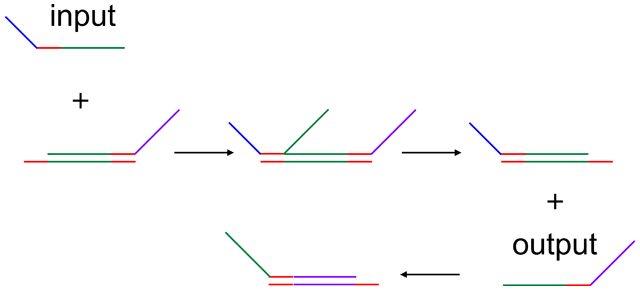Figuring out the structure of DNA, and the ongoing research into its workings, have provided scientists with a lot of new knowledge. One of the, perhaps unexpected, new areas of research that have sprouted forth from this knowledge, is the area of DNA computing, where DNA molecules are used to perform computational operations.
A new study has developed a DNA computer that is able to calculate the square root of whole numbers up to 15 and round the answer to the nearest whole number. By using nothing but strands of DNA, Qian and Winfree (2011), have been able to design a biochemical circuit able to perform this basic calculation. To do it, DNA strands that encoded for the input (one strand per binary digit of the input number, up to four binary digits possible, thus up to 15) were added to the solution which contained the system of DNA logic gates, which were composed out of double-stranded DNA molecules with some ‘openings’ where the input strands could get a hold and ‘unzip’ the double strand while binding to one of the strands, thereby making a new double-stranded molecule by ‘pushing’ a strand off (as shown in Figure 1).

Figure 1: The basic idea involved in this DNA computation.
(Source: Ars Technica,_http://arstechnica.com/science/news/2011/06/dna-logic-gates-calculate-a-square-root-using-130-different-molecules.ars)
After a while, the chemical cascade caused by the DNA gate system can be interpreted by using fluorescent colors. Four such colors represent each possible state in the two-digit answer, with one color representing ‘0’ and another one ‘1’ for each digit of the answer.
As the calculation can last up to 10 hours, it seems highly unlikely that these DNA computers will ever rival regular computers. But that has never been the goal of this research. The idea is that, through incorporating such DNA computers in living cells (which still poses a great challenge), they could subsequently be used as, for example, disease detector. There are even ideas to link the output to biological functions, such as gene expression. By doing so, these disease detectors could even perform some sort of therapeutically relevant role.
References
Qian, L. and Winfree E. (2011). Scaling Up Digital Circuit Computation With DNA Strand Displacement Cascades. Science. 332(6034), pp. 1196 - 1201.




Comments